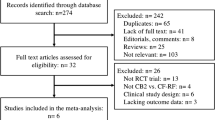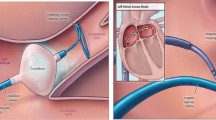Abstract
Background
The newer second-generation cryoballoons (CB-2 or Arc-Adv-CB) have been shown to achieve significantly lower temperature and faster pulmonary vein isolation (PVI) time in comparison with first-generation cryoballoons (CB-1 or Arc-CB). To test the premise that second-generation cryoballoons can improve clinical outcomes in comparison to first-generation cryoballoons in terms of safety and efficacy, we pooled data for systemic review and meta-analyses from all available literature comparing their clinical performance.
Methods
The Cochrane Library, PubMed, Google Scholar, and studies presented at various meetings were searched for any published literature comparing safety and efficacy of the second-generation cryoballoons (Arctic Front Advance cryoballoons) with first-generation cryoballoons (Arctic Front Cryoballoons). A total of ten published studies, with 2310 patients, were included in this meta-analysis with 957 patients in second-generation cryoballoon group and 1237 patients in first-generation cryoballoon group.
Results
The pooled analysis showed significant superiority of second-generation cryoballoons in terms of less procedure time, less fluoroscopic time, and fewer incidences of arrhythmia recurrences compared to first-generation cryoballoons at the cost of higher incidence of persistent and transient phrenic nerve palsy. The differences in the rate of pericardial effusion and incidence of access site complications were not statistically significant.
Conclusions
Second-generation cryoballoons are associated with a shorter procedure time and fluoroscopy time, along with lower arrhythmia recurrence rates, reflecting higher procedure efficacy when compared to first-generation cryoballoons. However, they are also associated with a higher incidence of transient and persistent phrenic nerve palsies with a non-significant difference in rates of access site complications and pericardial effusion.








Similar content being viewed by others
Abbreviations
- CBA:
-
Cryoballoon ablation
- PVI:
-
Pulmonary vein isolation
- AF:
-
Atrial fibrillation
- CB-1:
-
First-generation cryoballoons
- CB-2:
-
Second-generation cryoballoons
- PNP:
-
Phrenic nerve palsy
- OR:
-
Odds ratio
- SDM:
-
Standard difference in mean
- CI:
-
Confidence interval
- ICT:
-
Intra-cardiac thrombus
- VHD:
-
Ventricular heart defect
- LFT:
-
Liver function test
- AC:
-
Anticoagulation
- UC:
-
Ulcerative colitis
- HF:
-
Heart failure
- GA:
-
General anesthesia
- MI:
-
Myocardial infarction
- CHD:
-
Congenital heart defect
- AFL:
-
Atrial flutter
References
Piccini, J. P., Lopes, R. D., Kong, M. H., Hasselblad, V., Jackson, K., & Al-Khatib, S. M. (2009). Pulmonary vein isolation for the maintenance of sinus rhythm in patients with atrial fibrillation: a meta-analysis of randomized, controlled trials. [Meta-analysis research support, Non-U.S. Gov’t]. Circulation. Arrhythmia and Electrophysiology, 2(6), 626–633.
Neumann, T., Vogt, J., Schumacher, B., Dorszewski, A., Kuniss, M., Neuser, H., et al. (2008). Circumferential pulmonary vein isolation with the cryoballoon technique results from a prospective 3-center study. [Multicenter study]. Journal of the American College of Cardiology, 52(4), 273–278.
Tang, M., Kriatselis, C., Nedios, S., Ye, G., Roser, M., Fleck, E., et al. (2010). A novel cryoballoon technique for mapping and isolating pulmonary veins: a feasibility and efficacy study. [Research support, Non-U.S. Gov’t]. Journal of Cardiovascular Electrophysiology, 21(6), 626–631.
Coulombe, N., Paulin, J., & Su, W. (2013). Improved in vivo performance of second-generation cryoballoon for pulmonary vein isolation. [Research support, Non-U.S. Gov’t]. Journal of Cardiovascular Electrophysiology, 24(8), 919–925.
Casado-Arroyo, R., Chierchia, G. B., Conte, G., Levinstein, M., Sieira, J., Rodriguez-Manero, M., et al. (2013). Phrenic nerve paralysis during cryoballoon ablation for atrial fibrillation: a comparison between the first- and second-generation balloon. Heart Rhythm, 10(9), 1318–1324.
Martins, R. P., Hamon, D., Cesari, O., Behaghel, A., Behar, N., Sellal, J. M., et al. (2014). Safety and efficacy of a second-generation cryoballoon in the ablation of paroxysmal atrial fibrillation. Heart Rhythm, 11(3), 386–393.
Straube, F., Dorwarth, U., Vogt, J., Kuniss, M., Heinz Kuck, K., Tebbenjohanns, J., et al. (2014). Differences of two cryoballoon generations: insights from the prospective multicentre, multinational FREEZE Cohort Substudy. In Europace (Vol. 16, pp. 1434–1442, Vol. 10). England: Published on behalf of the European Society of Cardiology The Author 2014. For permissions please email: journals.permissions@oup.com.
Liu, J., Kaufmann, J., Kriatselis, C., Fleck, E., & Gerds-Li, J. H. (2015). Second generation of cryoballoons can improve efficiency of cryoablation for atrial fibrillation. Pacing and Clinical Electrophysiology, 38(1), 129–135.
Greiss, H., Berkowitsch, A., Wojcik, M., Zaltsberg, S., Pajitnev, D., Deubner, N., et al. (2015). The impact of left atrial surface area and the second generation cryoballoon on clinical outcome of atrial fibrillation cryoablation. Pacing and Clinical Electrophysiology, 38, 815–824.
Furnkranz, A., Bordignon, S., Schmidt, B., Perrotta, L., Dugo, D., De Lazzari, M., et al. (2015). Incidence and characteristics of phrenic nerve palsy following pulmonary vein isolation with the second-generation as compared with the first-generation cryoballoon in 360 consecutive patients. In Europace (Vol. 17, pp. 574–578, Vol. 4). England: Published on behalf of the European Society of Cardiology The Author 2015. For permissions please email: journals.permissions@oup.com.
Aryana, A., Morkoch, S., Bailey, S., Lim, H. W., Sara, R., d’Avila, A., et al. (2014). Acute procedural and cryoballoon characteristics from cryoablation of atrial fibrillation using the first- and second-generation cryoballoon: a retrospective comparative study with follow-up outcomes. Journal of Interventional Cardiac Electrophysiology, 41(2), 177–186.
Aytemir, K., Gurses, K. M., Yalcin, M. U., Kocyigit, D., Dural, M., Evranos, B., et al. (2015). Safety and efficacy outcomes in patients undergoing pulmonary vein isolation with second-generation cryoballoondagger. In Europace (Vol. 17, pp. 379–387, Vol. 3). England: published on behalf of the European Society of Cardiology The Author 2014. For permissions please email: journals.permissions@oup.com.
Chan, N. Y., Yuen, H. C., Chu, P. S., Choy, C. C., Chow, H. F., Fong, H. F., et al. (2013). Inner lumen mapping catheter-facilitated big cryoballoon treatment for atrial fibrillation shortens procedural duration and fluoroscopic exposure with comparable mid-term efficacy. Journal of Interventional Cardiac Electrophysiology, 37(2), 169–177.
Furnkranz, A., Bordignon, S., Schmidt, B., Gunawardene, M., Schulte-Hahn, B., Urban, V., et al. (2013). Improved procedural efficacy of pulmonary vein isolation using the novel second-generation cryoballoon. Journal of Cardiovascular Electrophysiology, 24(5), 492–497.
Calkins, H., Kuck, K. H., Cappato, R., Brugada, J., Camm, A. J., Chen, S. A., et al. (2012). 2012 HRS/EHRA/ECAS Expert Consensus Statement on Catheter and Surgical Ablation of Atrial Fibrillation: recommendations for patient selection, procedural techniques, patient management and follow-up, definitions, endpoints, and research trial design. In Europace (Vol. 14, pp. 528–606, Vol. 4). England.
Tzou, W. S., Marchlinski, F. E., Zado, E. S., Lin, D., Dixit, S., Callans, D. J., et al. (2010). Long-term outcome after successful catheter ablation of atrial fibrillation. Circulation. Arrhythmia and Electrophysiology, 3(3), 237–242. United States.
Wokhlu, A., Hodge, D. O., Monahan, K. H., Asirvatham, S. J., Friedman, P. A., Munger, T. M., et al. (2010). Long-term outcome of atrial fibrillation ablation: impact and predictors of very late recurrence. Journal of Cardiovascular Electrophysiology, 21(10), 1071–1078. United States: 2010 Wiley Periodicals, Inc.
Lim, H. W., Cogert, G. A., Cameron, C. S., Cheng, V. Y., & Sandler, D. A. (2014). Atrioesophageal fistula during cryoballoon ablation for atrial fibrillation. Journal of Cardiovascular Electrophysiology, 25(2), 208–213.
Sacher, F., Monahan, K. H., Thomas, S. P., Davidson, N., Adragao, P., Sanders, P., et al. (2006). Phrenic nerve injury after atrial fibrillation catheter ablation: characterization and outcome in a multicenter study. Journal of the American College of Cardiology, 47(12), 2498–2503.
Author information
Authors and Affiliations
Corresponding author
Ethics declarations
Conflict of interest
The authors have no conflict of interest to declare.
Rights and permissions
About this article
Cite this article
Pandya, B., Sheikh, A., Spagnola, J. et al. Safety and efficacy of second-generation versus first-generation cryoballoons for treatment of atrial fibrillation: a meta-analysis of current evidence. J Interv Card Electrophysiol 45, 49–56 (2016). https://doi.org/10.1007/s10840-015-0075-4
Received:
Accepted:
Published:
Issue Date:
DOI: https://doi.org/10.1007/s10840-015-0075-4




